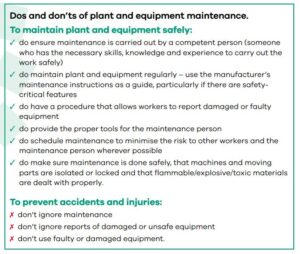Unsafe maintenance has caused many fatalities and serious injuries.
Using the correct piece of equipment for a job and having it used by someone that knows what they are doing always achieves a better result. Inspecting that equipment and carrying out maintenance so it remains functioning properly can help to reduce costs associated with downtime. This all helps toward a productive and profitable business. Amazing then that safety regulations have exactly the same goals.
The Provision and Use of Work Equipment Regulations 1998 (PUWER) requires that employers provide work equipment suitable for the task and those that are managing, supervising and using the work equipment are suitably competent.
The Regulations also require work equipment to be inspected and maintained. So how does this impact on better safety? An effective inspection and maintenance programme helps to reduce unplanned breakdowns. Interventions with work equipment presents different risks than during running conditions. Often guards have to be removed to undertake the maintenance, and access may be more difficult. Add into this the unexpected nature of a breakdown usually means it is in the most awkward situation and most time critical part of a job, and it is easy to see how risk can increase in a breakdown situation. Unmaintained equipment may have some safeguards fall into disrepair and so the risk of operation can increase. Maintenance needs to be correctly planned and carried out. Unsafe maintenance has caused many fatalities and serious injuries, either during the maintenance or to those using the badly maintained or wrongly maintained/repaired equipment.
PUWER requires that:
- all work equipment be maintained in an efficient state, in efficient order and in good repair.
- maintenance operations on work equipment can be carried out safely
- where any machinery has a maintenance log, the log is kept up to date. HSE recommend that all high risk machinery does have a maintenance log .Tilhill view is that all Forestry machinery is high risk.
If you are an employer and you provide equipment for use, from hand tools and ladders to electrical power tools and larger plant, you need to demonstrate that you have arrangements in place to make sure they are maintained in a safe condition.
Who can maintain work equipment?
Maintenance work should only be carried out by those who are competent to do the work, and have been provided with sufficient information, instruction and competence training.
With high-risk or complex equipment, these demands may be significant and, in some cases, may be best undertaken by the manufacturer or specialist contractors. However, in many cases, maintenance can be done in-house by suitably trained, competent staff.
For some maintenance work, for example the changing of abrasive wheels, there are well-established industry training schemes. In other cases, such as for the use of small- scale scaffold towers, sufficient training may be provided by the equipment hirers. In other work, such as with hand-held chainsaws, training on the safe maintenance of the equipment is normally provided as an integral part of the basic training in its safe safe use.




